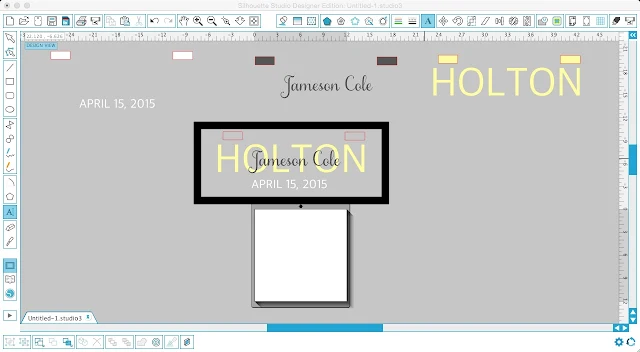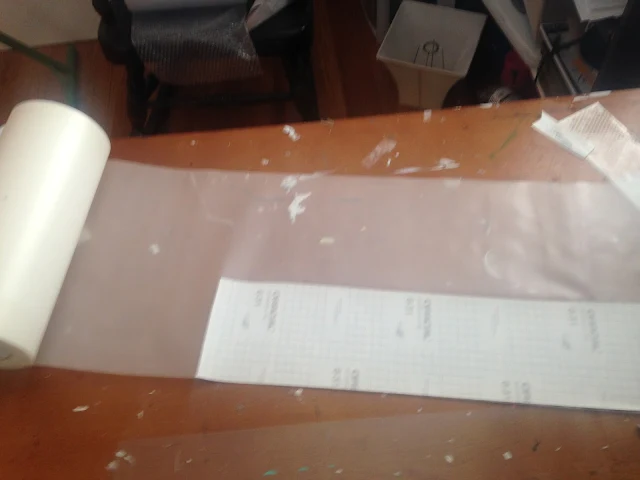There are actually at least four different ways to go about it.
The method you pick will depend on a few different things:
- Preference
- Type of frame (single or double pane glass)
- Experience and comfort layering vinyl
- Time restraints
For the first three methods explained here, the vinyl would go on the front of the back piece of glass so it is essentially sandwiched between the glass and can't be 'felt' when the frame is all together.
Wet Method - If you're only using a single color vinyl, the wet method explained here may be the best option for you. It is great for avoiding bubbles when applying vinyl to glass. Plus it gives you a little wiggle room when applying since you can slightly adjust the positioning of the vinyl.
Straight Layering - If you're using more than one color of vinyl, you can physically layer the vinyl on top of each other. The easiest way to do this is to use registration marks like you would on any other vinyl layering project. This layering method is pretty no-fail which is great. On a single pane of glass, however, be aware the bottom layer of vinyl will cause the top layer to have a slight ridge at the overlap site.
Layering with Subtract All - If you're layering vinyl but don't like the look of overlapping vinyl because of the ridges it creates at the overlaps spots, you can subtract out the overlapping areas of the bottom layer. I demonstrated and explained this anti-bulk layering method here (referring to HTV, but it's the same for vinyl with the addition of registration marks for re-alignment).
I consider this the most difficult method because although you will add registration marks to line up and layer the vinyl after it's cut, it's very difficult to make a large design perfectly match up so you don't see any of the subtracted areas.
Double Pane Layered Vinyl - The method I went with is what I think both works and looks the best - plus it's pretty fast. The nice thing about a glass floating frame is that most will have two panes of glass...that is after all how you get the floating effect. However, if you don't like having vinyl on the front of the front piece of glass, you'll want to choose one of the above options so you can sandwich the vinyl between the two panes of glass. I would rather have vinyl on the front pane of glass, than have bumps or deal with subtracting areas which is why I favor this method.
With three colors of vinyl for this project, I simply cut each one in its entirety - no reg marks or subtracting. For this project, I used 24x12" matte Oracal 631 from Expressions Vinyl because I like the look of matte on glass. In case you're currently on a yellow and dark gray kick like me, the colors I picked are:
- Maiz
- Dark Gray
- White
After it was cut, I simply weeded the vinyl like I normally would.

I started by adding the yellow layer to one pane of glass with clear transfer tape. Tip: Lay the transfer tape down flat then flip the vinyl piece onto the transfer tape to make sure there are no bump or bubbles.
I used my favorite hinge method to perfectly align, position and ensure the vinyl was straight when applying it to the glass. I explained in depth how to work the hinge method here.
Then I moved to the second pane of glass and added the gray layer the same way with the hinge Here's a trick....put the bottom or back layer of glass down onto a flat surface. Then put the top layer of glass down on top of it. You'll get a good idea of what the layered vinyl will look like this way. You will still need to use your ruler and hinge method to perfectly apply, but this gives you a real advantage to see the finished project before you commit.
And just to show you how the vinyl is actually not layered, but on two different pieces of glass...
I had a third vinyl layer too, the date which was in white. It doesn't really matter which pane of glass I put this on because it's all going to look like one layer when I put the frame together. I decided to put it on the yellow/bottom layer simply because that's just less vinyl that can be touched since it's on the inside.
Now here's what I have when all the vinyl is on the glass.
And you're all done! Simply put your frame back together, wipe it down to remove any smudges if necessary and then hang it up to display!
I apologize in advance for this picture, it's impossible to photograph floating glass frame between the glare and the shadows. This is the best I could get to show you the finished look of the glass frame with vinyl.
Note: This post may contain affiliate links. By clicking on them and purchasing products through my links, I receive a small commission. That's what helps fund Silhouette School so I can keep buying new Silhouette-related products to show you how to get the most out of your machine!
Thanks for coming to class today at Silhouette School. If you like what you see, I'd love for you to pin it!

Get Silhouette School lessons delivered to your email inbox! Select Once Daily or Weekly.















.png)




What a beautiful gift idea, Melissa. I absolutely love the fonts you used for this frame. Would you be willing to share the fonts you used? Thanks so much.
ReplyDeleteLove this idea, it would also be great for a wedding gift adding both names and date of wedding.
ReplyDeleteCould you do this with one piece of glass putting the 1 color on the back of the glass and the other on the top of the glass? That would get rid of the bump of the vinyl over vinyl and cut down the cost and weight of your fraim.
ReplyDeletePaulette-I have done just that. Not only does it weigh less but I find single pane frames are cheaper. Just remember to mirror the word going on the back.
DeleteI L-O-V-E this! My niece is due any day now and we already know her name. I'm buying a frame tomorrow. And as far as the pictures go, I love the way the shadows show! They add to the quality and uniqueness of the project.
ReplyDeleteHi, Yes fonts used please? thanks!
ReplyDeleteWhat transfer tape did you use? I'm having trouble getting my 631 to stay on the glass
ReplyDeleteI would suggest another way if using the double pane method. On the outer piece of glass, I would mirror the fist layer of vinyl, and apply it to the inside. This would give the first layer a little more depth. Then, you could apply the second layer to the front of the rear glass normally. This method would also protect the first layer from possibly being damaged when the glass is cleaned. Just my thoughts.
ReplyDeleteSo is the glass piece with "Jameson Cole" have the vinyl exposed to the front? Meaning its not protected?
ReplyDeleteAlso, most frames that you buy dont include two pieces of glass so what would you suggest doing for that?
Cut the glass yourself or go to a glass shop and have them cut one for you. I cut all of my own glass from old windows that I scavenge. You just have to be sure it's not safety glass.
DeleteWhere did you get your frame? I love the size and the double pane. Not finding one similar anywhere.
ReplyDelete